This is the first of 18 blogs that will cover our recent trip to Western Australia. While we did not have our Roamer for this trip, it was still a great adventure. Our 35-day exploration of Western Australia was two separate treks with just Pam and me using Airbnbs that bookended a standard commercial tour with relatives. As a little background, the trip was initiated by Pam’s aunt, who lives in Canberra and always wanted to visit the Kimberly region of Western Australia. We flew to Perth a couple of weeks before the commercial tour was to begin, rented a car and headed up the west coast to start the first trek.
Perth is near the southwest corner of Australia, and the capital of Western Australia. It is a beautiful city of about 2 million folks, where the total population of Western Australia is roughly 3 million and the land area about 9 times the state of Arizona. To give some perspective on Perth’s location, if you drilled through the center of the earth from Perth you would come out near Bermuda. It was the middle of the winter there, but due to its location the weather was very nice.
We made the trip to Perth in one day, flying from Phoenix to LA, then to Brisbane and finally arriving in Perth after crossing nine time zones and the international date line. After checking into our hotel, we found out that our ferry to take us to Rottnest Island the next afternoon was cancelled due to an incoming winter storm. Luckily, we were able to re-book on the early morning ferry, which wasn’t a problem since we were wide awake at 3am due to the time shift. The storm was not as bad as predicted, but we did have about 10-foot seas on the way over. Pam, who does not do well with motion sickness, took some ginger pills and made it over ok. A couple of other folks on the ferry did not.
Looking towards the dock on Rottnest Island, the storm moved over with just light, intermittent rain all day. The nice thing about being from the desert is that a cloudy, rainy day is actually a nice change.
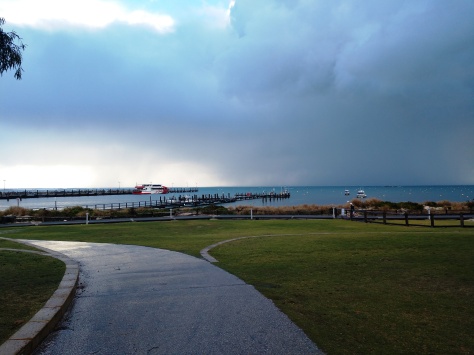
Rottnest Island is about 7 square miles in area, located just 10 miles off the mainland and is now a popular tourist stop due to its beautiful beaches and the Quokka, the friendly little marsupial that is now famous due to selfies. The Dutch fist discovered the island nearly 400 years ago and the explorers mistook the quokka for rats, hence Rottnest Island, or Rat Nest Island in Dutch.
The deserted island was used as a prison for Aboriginals in the early days of Australia and even had a reform school for wayward boys. It was also the staging area for tall ships at the turn of the previous century awaiting approval to enter Fremantle, the port city of Perth. Now most of the government buildings have been converted to restaurants, galleries and hotels.
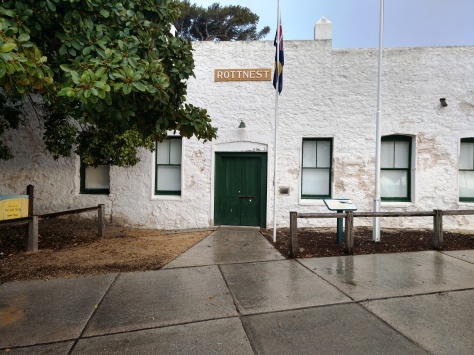
Much of the island is unpopulated, but around the small town near the docks the quokkas are everywhere. As we were to figure out quickly, to speak Australian you substitute the letter A for nearly every vowel and replace any word ending in R with an A. Therefore, quokka is pronounced as (kwa-ka) and water is (watta). Even though it was English, it took me awhile to get used to the inflection and cadence. At one point on the island we ran into an Australian couple talking to a Scottish couple. While both were speaking English, one with all vowels and the other with all consonants, I had no idea what was said – lol.

As we walked around town, we came across many quokkas. They are not afraid of people and are very cute and curious. Here one came right up to see what I possibly had for it to eat.
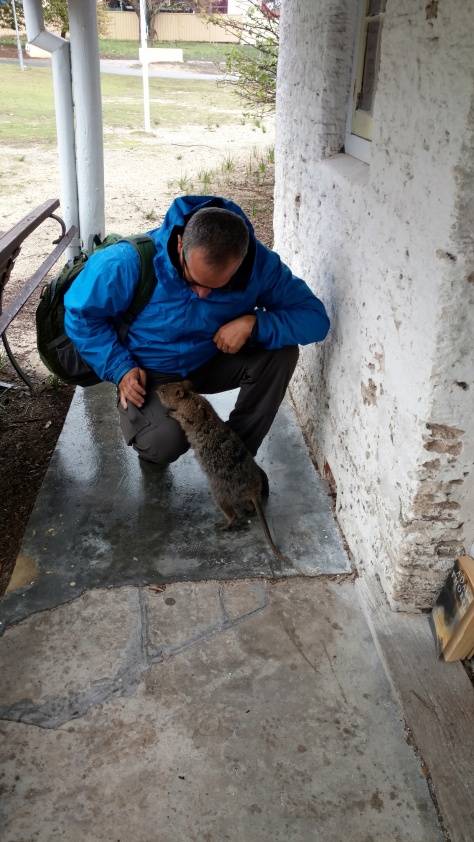
Pam tried to get a selfie with another quokka. If you just sit stationary, they will come to you. However, they may not do exactly what you want for a good picture.

The camera angle was a little off for a selfie, but they are cute little buggers. You are not supposed to feed them or pick them up since they are wild. It was mating season and one tourist got nipped on his head trying too hard to get the perfect selfie.
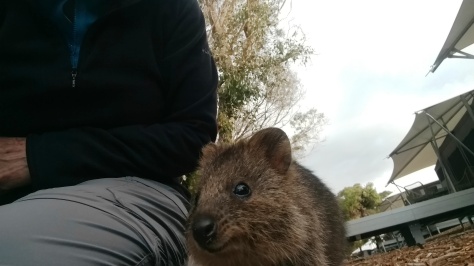
One of the first purchases we made in Australia was a book on the Birds of Western Australia to keep track of the different birds we saw. We caught this peacock catching some sun between rain showers on our walk around town, which was ironic since it was the only bird we saw not in the bird book (introduced). It was still a nice-looking bird.

Rather than stay in a condo or hotel on the island we booked a place at an “Eco-Sustainable Resort”, otherwise known as a high-end tent near the beach.

It was our introduction to “glamping” as its known, where our tent had electricity and a full bath. You had a door you could lock, but then you could just unzip the walls and walk through too – lol. Being winter and a little stormy the tent canvas rippled with the wind and it was chilly at night but nice for sleeping.

Since most of the places we booked on this trip were off the beaten path we had many evening meals of light snacks and a good bottle of Western Australian wine. Food and gas were more expensive, but the exchange rate was favorable, 70 cents US to a dollar Australian. Most restaurant food was reminiscent of British fare, but we did find the fish excellent.

The storm passed by sunset and the next day dawned with beautiful blue skies. We bought a daily bus pass that allowed us to jump on and off the bus that circled the island all day. We took it out to the furthest point and got off to explore.
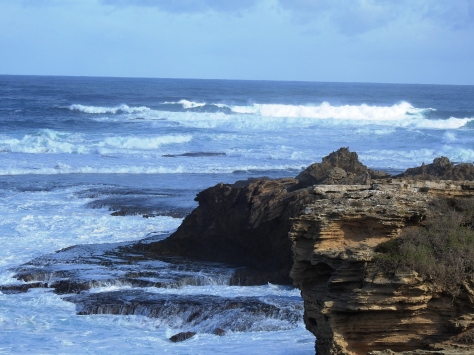
The hike back took us from rocky cliffs to beautiful beaches where most of the time we were the only ones on the trail. We spotted this white-faced heron along the cliffs, our first true Australian bird.

The hiking path was a nice dirt track that ran along the crest of the rocky shore.
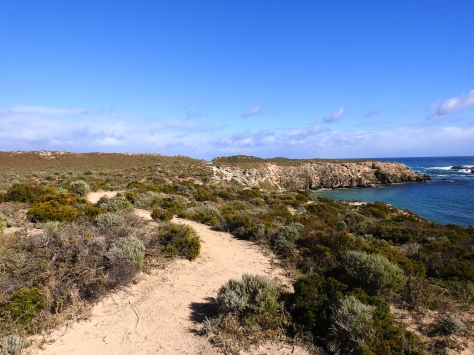
In one cove we spotted a group of New Zealand fur seals relaxing and regulating their body temperature by raising one of their fins into the air.

Other parts of the hike dropped you onto secluded beaches. The number of mooring balls in the bay indicate that it must be packed with boats while the folks enjoy the beach on summer weekends.
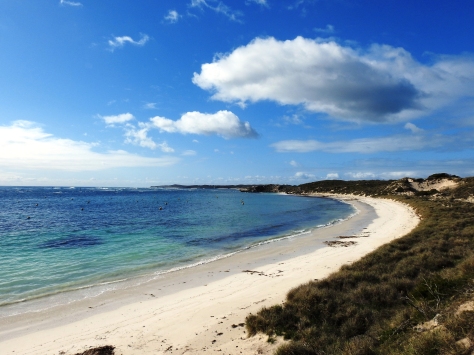
We spotted this colorful Australian Shelduck in the seaweed along the beach.

Then we spotted the Australian Pelican, which is a very impressive bird at 5 to 6 feet in height. Even at a distance the bird looked huge.

The island was very colorful and must be a great getaway destination for those folks living around Perth.

You can see the skyline of downtown Perth on the horizon from the eastern tip of the island.

We stopped in the historic boat shop and spoke with the curator. In the days of the tall ships these row boats made the 10-mile crossing from Perth to the island to let the ships know who was cleared to enter the harbor and to bring the local captain aboard. Then the rowboat was either towed by the ship or they had to row back to Perth, sometimes several times a day.

When we told the curator that we were from the US he told us that he was originally from Newcastle in eastern Australia. He worked in construction and several of the older buildings in Newcastle were built using the bricks salvaged from the 1906 San Francisco earthquake that made it to Australia as ship’s ballast.
The ride back to the mainland was much smoother than the trip out and then we started north up the coast.
